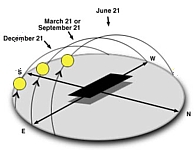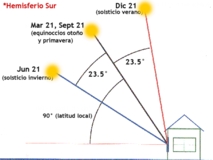2) The Sun minimally varies the exact position from which it rises daily.
 In the example above, a few days are enough to notice that the Sun appears from the same point at its "rise" and sets from the same opposite point at its "set". But taking this exercise a little further, and if you intend to use a simple device to determine the exact position of the Sun (something as rudimentary as a geometric cross), it can be seen that the Sun varies its rising position only slightly over time. To notice it clearly, a follow-up of at least 1 month would be necessary, but going much further, say from 6 months to 1 year, not only can this variation be observed, but it also seems to "stop" at a moment, and then go back.
In the example above, a few days are enough to notice that the Sun appears from the same point at its "rise" and sets from the same opposite point at its "set". But taking this exercise a little further, and if you intend to use a simple device to determine the exact position of the Sun (something as rudimentary as a geometric cross), it can be seen that the Sun varies its rising position only slightly over time. To notice it clearly, a follow-up of at least 1 month would be necessary, but going much further, say from 6 months to 1 year, not only can this variation be observed, but it also seems to "stop" at a moment, and then go back.
Preliminary conclusion: Variation in the position of the SunDepending on whether the shift is observed for about 1 month, or more extensively for more than 6 months, the observer can conclude that the sunrises and sunsets are not something perfectly "synchronized" or repetitive, but rather that they experience a variation, which (if extensive monitoring was done) can actually be determined as a cycle, since the shift advances, stops and goes backwards, but always moves within the same range.
3) The Sun gradually describes a shorter or longer "trace" in the sky, and consequently its maximum height above the horizon will vary.
 Related to the previous exercise, the Sun's positional variations during its rise also imply 2 possible phenomena to be observed: that the path or trajectory that it describes in the sky will be shorter or longer (depending on the moment in which the variations begin to be followed), so the maximum height it reaches in the sky will be higher or lower. To appreciate this difference in height, a very rudimentary instrument such as a geometric cross is also needed, and at least 1 month of monitoring to appreciate differences. The appreciation of a shorter or longer path is directly related to the "length of the day", that is, the time it takes for the Sun to rise and set. To determine this, a rudimentary technique can also be used, such as measuring the shadow (related to the 3rd experiment), but if you want to do it yourself, you can do it yourself. trap, you can simply use a watch to notice the different duration (if the tracking is brief it will only be variations of seconds or a few minutes).
Related to the previous exercise, the Sun's positional variations during its rise also imply 2 possible phenomena to be observed: that the path or trajectory that it describes in the sky will be shorter or longer (depending on the moment in which the variations begin to be followed), so the maximum height it reaches in the sky will be higher or lower. To appreciate this difference in height, a very rudimentary instrument such as a geometric cross is also needed, and at least 1 month of monitoring to appreciate differences. The appreciation of a shorter or longer path is directly related to the "length of the day", that is, the time it takes for the Sun to rise and set. To determine this, a rudimentary technique can also be used, such as measuring the shadow (related to the 3rd experiment), but if you want to do it yourself, you can do it yourself. trap, you can simply use a watch to notice the different duration (if the tracking is brief it will only be variations of seconds or a few minutes).
Preliminary conclusion: Different length of the day and existence of seasonsThe longest or shortest trajectory, complemented by a greater or lesser height above the horizon, respectively, allows to identify a longer or shorter day length, which, again, in the case of an extensive monitoring (6 months to 1 year) allows to determine it as a cycle that moves in a range of maximum and minimum height (and a maximum and minimum "trace"). Additionally, depending on the length of the experiment and climatic conditions of the observation site, the periods of longest and shortest day length can be associated with moments of greatest heat and cold, respectively.

